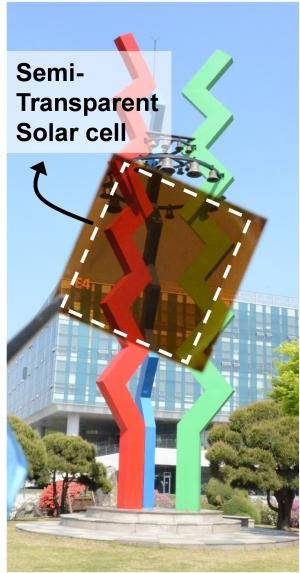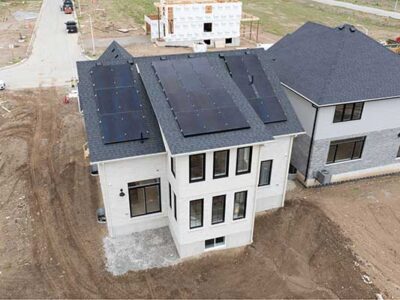Scientists are exploring ways to develop transparent or semi-transparent solar cells as a substitute for glass walls in modern buildings with the aim of harnessing solar energy. But this has proven challenging because transparency in solar cells reduces their efficiency in absorbing the sunlight they need to generate electricity.
Typical solar cells today are made of crystalline silicon, which is difficult to make translucent. By contrast, semi-transparent solar cells use, for example, organic or dye-sensitized materials. But compared to crystalline silicon-based cells, their power-conversion efficiencies are relatively low.
Perovskites are hybrid organic-inorganic photovoltaic materials, which are cheap to produce and easy to manufacture. They have recently received much attention, as the efficiency of perovskite solar cells has rapidly increased to the level of silicon technologies in the past few years.

Prototype of a semi-transparent perovskite solar cell with thermal-mirror functionality.
Copyright : Korea Advanced Institute of Science and Technology (KAIST)
Using perovskites, a Korean research team, led by Professor Seunghyup Yoo of the Korea Advanced Institute of Science and Technology and Professor Nam-Gyu Park of Sungkyunkwan University, has developed a semi-transparent solar cell that is highly efficient and functions very effectively as a thermal mirror.
One key to achieving efficient semitransparent solar cells is to develop a transparent electrode for the cell’s uppermost layer that is compatible with the photoactive material. The Korean team developed a ‘top transparent electrode’ (TTE) that works well with perovskite solar cells.
The TTE is based on a multilayer stack consisting of a metal film sandwiched between a high refractive index layer and an interfacial buffer layer. This TTE, placed as a solar cell’s top-most layer, can be prepared without damaging ingredients used in the development f perovskite solar cells. Unlike conventional transparent electrodes that only transmit visible light, the team’s TTE plays the dual role of allowing visible light to pass through while at the same time reflecting infrared rays.
The semi-transparent solar cells made with the TTEs exhibited an average power conversion efficiency as high as 13.3%, reflecting 85.5% of incoming infrared light. Currently available crystalline silicon solar cells have up to 25% efficiency but are opaque.
The team believes that if the semi-transparent perovskite solar cells are scaled up for practical applications, they can be used in solar windows for buildings and automobiles, which not only generate electrical energy but also allow smart heat management in indoor environments, thereby utilizing solar energy more efficiently and effectively.
Reference(s):
Research story: Korea Advanced Institute of Science and Technology | May 29, 2017 (source)













Comments